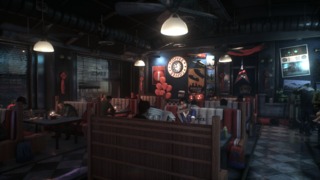
I’m about seven minutes into Batman: Arkham Knight, and all I want to do is go outside. I’m playing a police officer on his dinner break, and I’m standing in Pauli’s Diner, a busy little greasy spoon in Gotham City’s theater district. I’m supposed to go confront a stranger in the corner booth who is smoking, but I know that the second I do, the game will shift: Scarecrow will release his fear toxin and we’ll jump cut ahead to a Gotham evacuated of all its civilians, turned into (as a few reviewers have called it) a “playground for Batman” to try out his acrobatic and martial skills. So I’m doing everything except confronting that guy smoking in the corner.
I’ve heard jokes about Gotham all week from people playing Arkham Knight: “Who would even live in this town!?" “If you were smart, you would’ve evacuated after Arkham City!” “A supervillain is plotting mass murder? Just another Tuesday in Gotham!” (The best of this style of joke came in the form of Adi Robertson's “A goon grows in Gotham”).
But if you look beyond the Arkham games and the “Nolanverse,” you’ll see that that Gotham’s problems exist alongside its virtues. From the campy, vaguely Bostonian Gotham of the 1960s Batman TV Show to the art deco retro-futurism of Batman: The Animated Series, Gotham has as many interpretations as it does intersections, and a number of these match the crime and anxiety of urban life with culture, warmth, and community. As former Batman writer Grant Morrison once said, “Gotham needs as many faces as Batman--it should be the loudest, sexiest, jazziest city on Earth. It has the best restaurants, the best theaters, the best art, the best criminals, the best crimefighters etc etc. People put up with the weird crime for the sheer buzz.” And he’s right: It’s when the good and the bad of Gotham are both on display that I care most about the city and its caped crusader.
So, looking for proof of my Gotham, I drain all the character and life I can from this restaurant. I pace up and down the aisles of the diner, eavesdropping on conversations and reading the headlines on discarded newspapers. I spend some time staring at the bulletin board, scanning the mish-mash of concert flyers and travel brochures. At this point, the only thing I haven’t done is try to open the front door. I consider the possibility that Rocksteady might just let me open it and walk away. But in my lifetime of playing games, I’ve run into enough invisible walls and permanently locked doors to know that my chances of leaving this place behind are remarkably low.
And then the handle turns, and for a brief moment I can see Gotham alive. A city bus rumbles by in the rain. The ambient noise of the diner--spoons clinking in coffee cups, friends bickering--mixes with the low hum of the city. The lights of the signs across the way… and the door closes and I’m cut off.
I’m happy that developer Rocksteady anticipated my desire enough to let me open the door, but I can’t help but wish they’d given me more. There are lots of different kinds of Batman fantasies--and I’m not looking to invalidate any of them--but throughout this four game series, the developers have largely given me the same one over and over. For once, I want a Batman game where I’m compelled to save the day not because of abstract threats, damsels in distress, or a desire for personal vengeance, but because the beauty of Gotham City compels me to protect it. Instead, I’m left for the fourth time with Batman and his playground.
“Scum, criminals, and worse.”
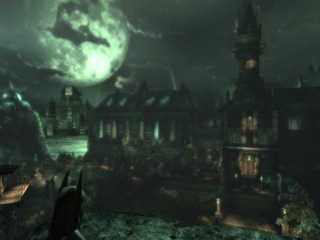
In the first game of the series, Rocksteady’s Batman: Arkham Asylum, this barely chafed against me at all. Asylum’s dangerous hub world connected separate levels filled with combat and stealth challenges. The whole thing had the plotting and pacing of a (good) Die Hard film. And while the detective mode challenges aren’t as developed as they would become in Arkham Origins and Arkham Knight, Asylum’s narrow focus ensured that the player still got to feel like the ever-observant Dark Knight. Over the course of the game, the player passed through the courtyards and tunnels of Arkham Asylum, watched as new threats appear and old ones were cleared away. Asylum’s version of the Batman fantasy highlighted how the hero’s intelligence and resilience let him win out against overwhelming odds: First, infiltrate a dangerous place. Then, survive long enough to learn its ins-and-outs (architecturally, historically, and socially). Finally, use that new knowledge to masterfully take down all of your adversaries.
With the shift to an open world in Batman: Arkham City, Rocksteady did tap into some other elements of Batman but they still offered up the same basic fantasy. By giving you the ability to glide across the city, grapnel-boosting from one rooftop to another, Arkham City lets you try on Batman’s legendary mobility. By dividing the prison city into sections run by different adversaries, Rocksteady gave the player the thrill of taking on established rogues instead of just recently freed bad guys. And by filling the open world with conversations to eavesdrop on (and to interrupt with sudden violence), Arkham City puts you in the shoes of Batman the vigilant do-gooder, ready to arrive in the knick of time to dispense justice. But this is where the fantasy begins to fall apart.
Scenes of Batman descending from the shadows to save the day are common across the franchise’s comics, films, and cartoons. But because there are no civilians to rescue, no living Gotham to protect, when Batman swoops down into a crowd of Arkham City’s goons it isn’t to save anything. It’s just to bust some skulls. To stop someone from shit talking him. To have a little fun.
Throughout the series, developers have tried to assuage this disconnect in a few ways. First, they sprinkled the groups of enemies with special targets that will divulge info on side objectives, like Riddler trophies. And in Arkham Knight, sometimes the criminals are menacing a civilian: A lost and wounded firefighter. But these efforts feel mechanical and soulless. I’m not anyone’s hero. That firefighter would lay on the ground and wait to be saved forever. None of these threats are real. I’m just checking off a box and moving on.
Underlying this problem is a disconnect in the way that criminals are depicted in the Arkham series from the way they are shown in many of the best examples of DC’s storytelling. In the intro to Arkham Knight, Police Commissioner Jim Gordon explains that the “only people left on the street are the kind that enjoy the chaos. Scum, criminals, and worse.” This free license to take out whoever, wherever misses one of the most interesting, recurring elements of Batman stories: Criminals don’t just arrive from the ether, fully formed and wholly evil. Like Batman himself, they have origin stories and sometimes even noble intentions.
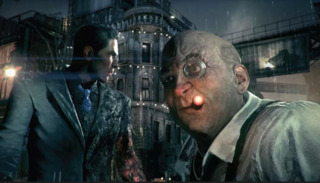
There are lots of ways to read Batman’s rogues gallery, but one of my favorite ways is to see them as a collection of people who’ve taken good things a little too far, sometimes even mirroring the history and traits of the Dark Knight. The Penguin has his own complex (and, because of how comics work, changing) history with Gotham’s class of elites--but unlike Bruce Wayne, he pursues wealth at any cost. Poison Ivy would certainly believe a Wayne Enterprises-funded report about irreversible climate changes, but her proposed solution to the problem would likely include the death of the scientists that did the research. Edward Nigma’s devotion to knowledge is admirable, but his desire to be the smartest person in the room often leaves everyone else in it dead. Bruce Wayne may don a second face when he fights crime, but unlike Harvey Dent, he keeps his identity solid and unified. While some Batman stories simply prop up Batman as defender of the status quo, the best ones explore the way these villains reflect the hero's own attributes back at him.
It isn’t just the super-villainous bad guys who have origins, though. Carmine Falcone, Rupert Thorne, and the rest of Gotham’s mobsters all come from a place, too. And even the “scum, criminals, and worse” that work for these criminals tend to reflect some failure of Gotham City: Poverty, failure of education, a lack of opportunity. (It’s for reasons like this that Grant Morrison’s version of Batman doesn’t just beat the hell out of thugs: He hires former convicts, operates charities, and attempts to buoy the cultural value of Gotham.) All of this is why Gordon’s line sits so ill at ease with me. It says “If they’re in a place like this, they must be criminals. And if they’re criminals, go to town on ‘em.” And given the world we live in, invectives like that will never make me feel heroic.
It isn’t only that Arkham Knight fails to humanize these villains, it’s that because of the way the game presents Gotham--empty of life, stuck in a state of emergency--it actually can’t. Those other Batman stories demonstrate the history, humanity, and purpose of the bad guys through scenes of Gotham alive and filled with people. Those stories offer us orphanages in disrepair, villains going on dates, ex-cons out of work and out of options, and criminal brilliance put to surprisingly moral use.
Don’t get me wrong, every Batman story isn’t The Wire, nor does it need to be. But this deep into the Arkham series, I would like to have seen some of that angle represented in these games, especially as they transitioned further into Gotham proper.
Perhaps what really stings for me is that so many other games have at least attempted to approximate the vibrance of cities. And some have been very successful.
Other Worlds, Other Cities
CD Projekt Red fills the world of The Witcher 3 with interesting people and places, and then doubles down on that in Novigrad, the game’s largest city. After hours spent in the no-man’s-land of Velen, where the player interacts mostly with scattered villages, woodland hermits, and the occasional military fortress, Novigrad feels like it overflows with people. Geralt’s presence as an outsider gives him unique potential in this cosmopolitan city, so he’s as important as he is in the wilderness. And yet Novigrad always seems somehow bigger than him. It is a meeting place for cultures, and the stories told in the city’s quests often address the tension and potential caused by Novigrad's diversity.
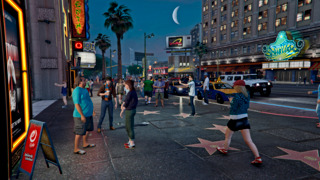
Players are anything but heroes in GTA V: The game encourages us to make havoc in the faux-SoCal sprawl of Los Santos. We knock over convenience stores, chase rival criminals along the ocean-side highways, and rob bigger and bigger banks during increasingly spectacular set piece heists. And yet Los Santos feels “alive.” I say that knowing how silly it is. It’s not like the AI civilians of Los Santos have homes, or intricate routines built around “needs” or “desires,” or even the pulled-from-a-hat identities that Watch Dogs’ inhabitants did. It’s not like the cityscape grows or changes over time. But there’s something about the way pedestrians mime out their lives, eating hot dogs, absentmindedly checking their phones while they cross the street, glaring at you when you bump into them... And all of this is set in a world filled with posters and advertisements and music and suit shopping. So no, Los Santos isn’t actually alive like Los Angeles (or even Skyrim or The Sims 3), but it does live the way the waves do, in a collection of small motions that add up to mean something more. (And it is interesting that a game focused on explosive, illegal chaos better offers the joys of a city than a game that puts you in the shoes of a hero.)
Superman Returns took a much more blunt-force approach to rendering Metropolis “alive”: It gave the city a health bar. It’s… Okay, listen, that game is bad. From the weightless combat to the repetitive structure to the fact that the last boss is a giant tornado... it’s bad. But the designers at EA Tiburon at least attempted to incorporate the notion of superhero-as-city-protector into their game: Superman couldn’t die (he’s Superman!), but he could be temporarily knocked on his ass. And when that happened, the bad guys went to work on Metropolis. It’s the lesson every comic book villain seems to know: When you can’t hurt the hero, hurt what’s important to them.
Superheroes don’t only protect cities, though, they also represent them. Batman represents all of the qualities of Gotham, just as Superman does his home turf. Sucker Punch went even further than that in Infamous: Second Son, going so far as to give that game’s characters powers that reflect the physical makeup of the modern city: Smoke, Concrete, Neon, Paper, Video. It was a surprising move after the classic elemental powers of the previous games, but that innovation was honestly my favorite thing about Second Son. That isn’t the most interesting thing about the way the Infamous games frames superheroics, though.
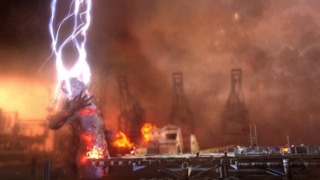
While I’m not the Infamous series’ biggest fan, I’ve never been shy to recognize that Sucker Punch has always been tuned into something important: The relationship between superheroes, cities, and trauma. The first game’s Empire City gestured towards a “worst case” fear about post 9/11 New York. The city’s inhabitants were hit by an event so terrible and shocking that it resisted clear description, and then they were forced to struggle and scrounge to survive, cut off from the rest of the country. Infamous 2 follows suit, leveraging Hurricane Katrina in both setting and structure. Not only is New Marias based on Gulf Coast areas like New Orleans, the basic structure of the game mirrors a weather map. As Stephen Totilo said, "The Beast approaches New Marais like a hurricane," and everyone is rushing to prepare, and the infrastructure in place just isn’t enough to confront the impending disaster. Even Infamous: Second Son was positioned as a sort of reaction to a disaster. But instead of a terrorist plot or a force of nature, that game’s city was faced with a crisis of government surveillance and control that reads like a reaction to the Patriot Act, the Snowden revelations, and at least a little bit of the Tea Party’s perspective on Big Government. This connection between superheroes, their cities, and moments of crisis is not unique to Infamous, though.
Over the last few years, as the Marvel film franchises have ascended and the DC movies try to find their footing, there has been a conversation about why we like superheroes and what the role of violence should be in their stories. Film reviewers and fandoms have discussed whether our superhero stories are improved or ruined when those films depict the loss of human life from super-powered collateral damage. There were many reactions to Zack Snyder’s Man of Steel, but none as loud as “Superman stories shouldn’t be so grim and brutal.” (A perspective that I suspect will be revisited in the future, if Batman vs. Superman's use of 9/11 imagery is any indication.) Two years later, Avengers: Age of Ultron pushed hard in the other direction, explicitly telling us that even one civilian death is too much to bear.
But both strategies have missed the mark for me. Man of Steel luxuriates in the violence done to Metropolis (and its residents), and it does this about 30 years too late to provocative or subversive. Meanwhile, Age of Ultron issues a confused message: “(American) superheroics and militarism hurt people, except for when they're done very, very carefully, and then they hurt no one--except maybe for a brave hero lost in the battle, and some unfinished buildings, I guess?” If Man of Steel fetishized loss, Age of Ultron largely wants to tell us that it’s totally avoidable. Which is a shame, because loss (and the fear of loss) is key to the superhero myth.
The Cities We Dream Of
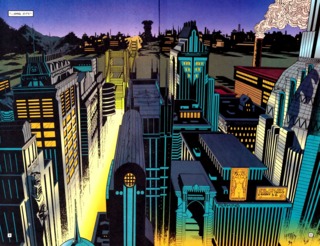
I write this just a month after moving back to the real Gotham. Or at least back to New York, one of the fictional city’s clearest inspirations.
New York is as diverse and storied as the Caped Crusader’s hometown. And like the fictional Gotham, New York is a city that has suffered through its own trauma, something so horrific that it is still hard to put into words that don’t feel somehow reductive. There is always something else to say, forever. And to live here, to talk to the people who lived through 9/11 (and all that followed), is to understand where the fantasy of the superhero might come from. To see something so vivid come under a threat so large and so nebulous, so much greater than any individual person or even any single human institution, creates in many a desire for something or someone to save us. And in a city, there is always something large and nebulous biting at your ankle, trying to convince you that the place you love is broken.
Our heroes reflect our cultural anxieties, and this isn’t unique to the heroes that wear capes and fly around. Think of the tall tales told about the people (fictional and real) who conquered the frontier with (nearly) superhuman acumen. Or consider the huge collection of suburban protagonists in our TV shows, movies, and novels who are just a little more checked-in than their high school rivals, or a little more dedicated to escaping the sprawl of identical neighborhoods. These places have their own anxieties and traumas, but superheroes are not rural or suburban as often as they are urban.
This is because cities have their own, unique anxieties. Sometimes, maybe over Thanksgiving dinner, the residents of cities have those anxieties (which they are keenly aware of) explained to them by their dismissive, suburban uncles. In practice, it sounds a lot like what people say about the fictional Gotham: “Why would you live in New York? It’s so cramped and busy and expensive! Do you ever feel unsafe? What about muggers? What about terrorists? What about… taxes?” There is anxiety that, in becoming a nexus for millions of people, cities like New York are breaking at the seams. A fear that our societal infrastructure cannot keep up with the needs of our collective social ambition, of the ambition of our cities.
And so superheroes symbolically fill the gaps that we fear that our infrastructure, no matter how well designed and managed, cannot. They save us from burning buildings, they protect our museums, they pull us from floods, they prevent the power plant from exploding, they stop ricocheting bullets from killing innocents, they help troubled kids to get out of shitty life situations. Superheroes sometimes even emerge directly from these anxieties--from the violence or infrastructural failure. And sometimes they work to address our fears even when the mask is off. If they happen to be rich, they’re philanthropists. If they happen to be reporters, they write about social injustice. If they’re lawyers, they work pro bono. Sometimes, superheroes even remind each other that they're not the only ones working long hours to keep things working.
And the best superhero narratives do more than offer bedtime-story assurance that these anxieties will be addressed and that we will be okay. They confront these fears directly, and ask, “What if even superheroes aren’t enough?”
Cities attract both those down on their luck and looking for work, and those on a hot streak, looking to celebrate. They attracted the naive urban planners of the early 20th century who believed a more symmetrical city grid could undo poverty, and at the same time they attracted those who aimed to exploit the poor and disenfranchised through predatory housing schemes. For every art gallery there is an underserved community. For every park, a shelter barely able to serve the people it was built to protect. The truth is that cities offer us a promise that is not always kept. But the promise is vital.
And Gotham and Metropolis are our own cities extended to their most ambitious and precarious. They are the cities of our dreams. Brighter, cleaner, fairer; darker, more historic, more complex. And so the promises of these cities must be “more” too.
At the core of it this is my problem: this is why I want to see Gotham alive with people and culture and museums and parties and schools and celebrations and life. Because superhero stories make the most sense to me when the promises of their cities are made clear. The promise is vital, and Rocksteady’s Gotham promises nothing.
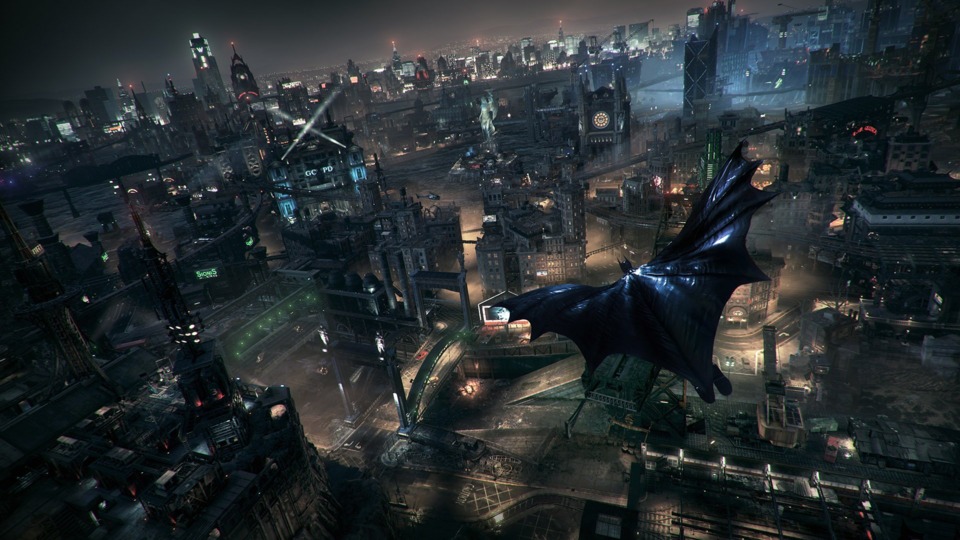
In the middle of writing this piece, I find this video clip. Someone’s modded Arkham Knight so that they can leave the diner and explore pre-evacuation Gotham. And what a sight it is.
As the trucks and buses pass through the player like ghosts, you can tell that these poorly textured civilian vehicles were not meant to be closely examined. In "detective mode," which gives him a sort of X-Ray vision, he can see the skeletons of the diner patrons subtly mimic life--a gesture here, a shift there. But the people outside the diner have no bones. They're solid, just a mass of what looks like red clay, frozen in strange, debug poses: Arms out in a T shape; hovering in the air in a seated position, arms resting on an invisible steering wheel.
Despite all this, I love it. The ambient rumble of cars passing by and the glow of the neon signage of the theater district. The way both sound and light are filtered through the rain. It is a shadow of a shadow of the game I want, but I love it.
At about five minutes in, the player in the video grapples up to the Gotham skyline, and heads towards the bridge connecting this island of Gotham to mainland. The neon lights disappear behind him. You can just barely hear the trucks charging by back near the diner, in their eternal, circular route. And up ahead, even though the city hasn’t come under Scarecrow’s attack yet, the cars have already piled up, halted in their pre-emptive evacuation of Gotham City.
The player leaps past them, and starts to cross the bridge on foot, but the gates are down. He grapples to the bridge’s gothic pillar and attempts to launch himself over the gate, but comes up shy. Maybe I’m seeing things, but I think there’s a frustration in how he moves. In one last try, he climbs up to the lamp-lit steel cables of the bridge, aligns himself outwards, and jumps from that slender line. As he tumbles toward the water, he aims to find another grapple point on the other side of the gate. He wants to go where the people of Gotham have gone. But he doesn’t get to follow them.
So he swings back towards the neon of the theater district, towards that objective in the corner, towards the cause of the evacuation that he paradoxically already hovers above. He runs under the light of the cheap motel sign, past the prop-like vehicles, swerving around the locked bodies in this lifeless world.
He makes it back to the diner, and pauses just outside the window. A couple of seconds pass, and then a man inside looks to check his watch. The player moves in a flash, as if this idle animation was a sharp, personal insult. He rushes up and slams into the glass window separating these two worlds, but it won't quite break. No amount of violence will bring the diner's simple but effective imitation of life out into Gotham City. And however clever the mod that let him out of the diner is, it doesn't fill the world with the humming activity of what's inside. So until Rocksteady (or someone else) figures out how to bring these two worlds together, I'm hanging up my cape and cowl. There are other "playgrounds" and other virtual cities. And while none of them glisten like Gotham at night, many of them blare out vibrantly, loud and alive.
117 Comments